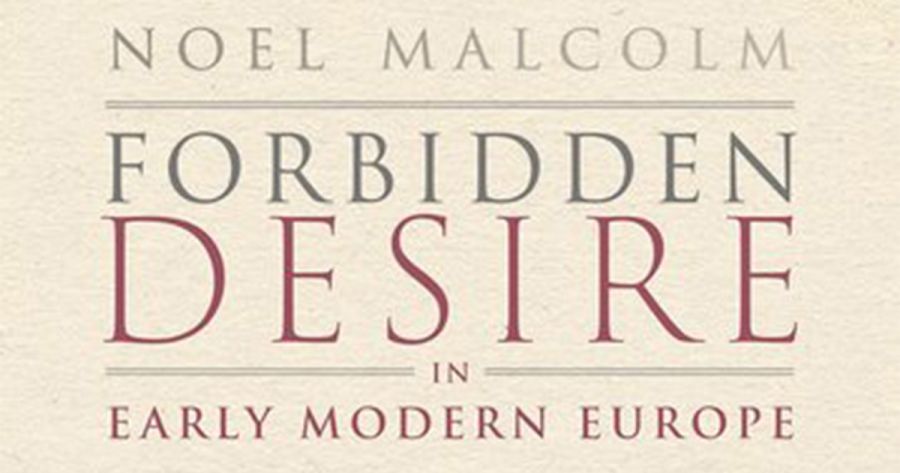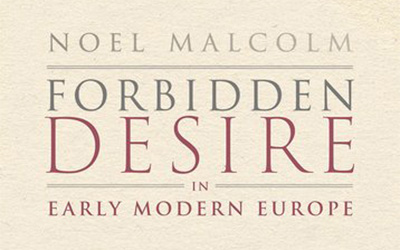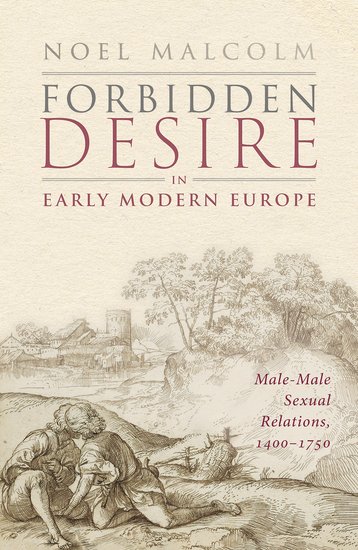
- Free Article: No
- Contents Category: History
- Review Article: Yes
- Article Title: Sodomites and catamites
- Article Subtitle: An engaging history of European homosexuality
- Online Only: No
- Custom Highlight Text:
Do gay men have a history – and, if so, what is it? Historians have grappled with such questions ever since Michel Foucault first published his History of Sexuality in the 1970s. The stakes are high because they are political: at root, they contest nature versus nurture. We know that men who have sex with other men have existed in every past society. But were those men the same as modern homosexuals? Many contemporary gays claim them as forerunners – yet several scholars see modern homosexuality as, fundamentally, a creation of contemporary late-stage capitalism and a chronological and cultural anomaly, whose associated rights may prove equally ephemeral.
- Featured Image (400px * 250px):

- Alt Tag (Featured Image): Miles Pattenden reviews ‘Forbidden Desire in Early Modern Europe: Male-male sexual relations, 1400-1750’ by Noel Malcolm
- Book 1 Title: Forbidden Desire in Early Modern Europe
- Book 1 Subtitle: Male-male sexual relations, 1400-1750
- Book 1 Biblio: Oxford University Press, £25 hb, 608 pp
- Book 1 Cover Small (400 x 600):

- Book 1 Cover (800 x 1200):

Noel Malcolm’s book is a new and learned entry into the contest to understand this history and its implications. Indeed, Oxford University Press promises it to be ‘a major new interpretation’ which rejects Foucault’s crude binary between the pre-modern ‘sodomite’ and the contemporary ‘homosexual’. And yet, as Malcolm admits in his Afterword, his book was born of an intellectual grudge that drives both its arguments and its organisation. The tragic irony here may be that Foucault’s crude binary does not exercise the hold on the field that Malcolm thinks it does in a work that appears to set out to demolish it. In pursuing a chimera, one sometimes fails to consider the bigger point.
Malcolm’s major contentions in this book are three. First, that Western observers of the Islamic world were not just prejudiced when they said the Ottoman Empire was a hotbed of sodomy: they spoke a truth that is well documented even by Islamic sources. Second, patterns of same-sex activity were essentially the same in the Western (i.e. Christian) Mediterranean as in the Eastern (i.e. Islamic): a social continuity existed across the religious boundary that encouraged, or at least tolerated, age-differentiated sex between men and boys. Third, early modern Europe’s North was more different from Europe’s South than that South was from the Islamic world: intergenerational same-sex relations were frowned on firmly there and the only ‘same-sexuals’ recorded seem to have been adult couples. These arguments are not new, although Malcolm is probably the only living scholar with the breadth of competences to demonstrate them exhaustively or empirically. He is a master historian with a remarkable flair for languages and an unusual rigour with evidence. His opening example, the case of Gregorio and Gianesino, two twinks from the Venetian colony in Istanbul who were the subjects of his ill-fated first foray into the field, illustrate this well. Others have written at length about what some Europeans were prone to call ‘the Italian vice’, yet none has linked it to the complex ‘in group, out group’ interactions which shaped such critical spaces of cultural encounter. A special concern to uphold not only honour but, above all, purity in the heart of the enemy’s territory lay at the core of official responses to this otherwise apparently mundane incident.
Some of Malcolm’s most engaging work in this book is in fact not merely connective but explicitly comparative of the Christian and the Islamic worlds. A series of learned disquisitions about both religions’ intellectual traditions surrounding same-sex activity show the Christian position to have been the more uncompromising. Malcolm rejects John Boswell’s well-known, but perhaps somewhat wishful, view that Latin theologians turned decisively against same-sex sexual expression only from the eleventh century. Yet he also shows how both Christianity and Islam were more nuanced in their moral classifications of same-sex sexual activity than either their detractors or fundamentalist believers now let on. A line from Cardinal Giambattista de Luca, the doyen of Counter-Reformation canon lawyers, surprises: he happily describes men who sodomise adolescent youths (as opposed to adult men) as engaged in ‘a certain urge which is, as it were, natural’. What might critics or defenders of the Catholic Church do with that line? Malcolm’s point, however, is far subtler. He tries to show how such normative expectations shaped the specific forms of same-sex sexual activity which prevailed in particular societies. Italians (and other Mediterranean men) indulged in pederasty not necessarily because they were unusually inclined towards it. It was merely the safest (i.e. best tolerated) form of same-sex sex in the circumstances.
Such arguments, of course, have major implications for how we understand the rights and status of gay people in the present. If the historical record of same-sex sexual encounters reveals not ‘innate’ preferences but only a series of socially conditioned responses, how can we write any history of gay people? How do we know which men who picked up boys on the streets of fifteenth-century Florence were shameless predators, whom today we would put on a sex offenders’ register, and which were unhappy gay males forced to conform to social expectations by regularly swapping older for younger lovers? Malcolm is firm that generalisations such as that ‘in the Renaissance, all men desired both women and boys’, or that a substantial majority of men (if not all) acted at some point on their desire for boys, are deeply problematic. There is no evidence that this was true. The related statement that ‘Europeans before 1700 presumed that all males desired both women and adolescent boys’ is less immediately hyperbolic but nevertheless still questionable. Such statements may have been the implication of prevailing literary discourses, but the prevalence of those discourses is nevertheless still not in itself evidence of majority opinion in societies where engagement with letters was decidedly élitist. What we can and cannot truly know about past lives is a subject that behoves caution. Malcolm is decidedly in the minimalist camp.
Much of this argument implicitly seems to echo remarks in David Halperin’s How to Do the History of Homosexuality (2002), a path-breaking theoretical analysis which is little engaged in Malcolm’s prose. Halperin’s point has been that we need to acknowledge the quite different ways same-sex desire (and identity) have been experienced across historical cultures, even when we recognise parts of the paradigm. Malcolm cautions much the same, albeit in a language that is dry as tinder. This is a story which makes some people very, very angry. Malcolm’s attempt to reduce the heat via a technical vocabulary (‘sodomites’, ‘catamites’, ‘mollities’, and so on) grates. (Why write social history if human interest or understanding the human condition is not a primary concern?) One suspects that Malcolm, a conservative intellectual, distances himself deliberately from what he may perceive as ‘activist’ approaches. But might it not have been preferable to adopt a middle ground which admitted more emotion? For many gay men today, the pre-modern is a past that still wounds because the intolerance and shame which many of them still feel appears to issue from it. Malcolm’s book could have been – and perhaps still is – a treasure trove of comparative information for them about the practices by which their same-sex attracted forebears ‘found’ each other and negotiated hostile environments. Malcolm could also surely have done more to understand why the twentieth century’s gay scholars, both pre- and post-Foucault, wanted to create the past that he views so suspiciously. The historian’s job is not merely to debunk their fantasy: it is also to understand how and why it came about.


Comments powered by CComment